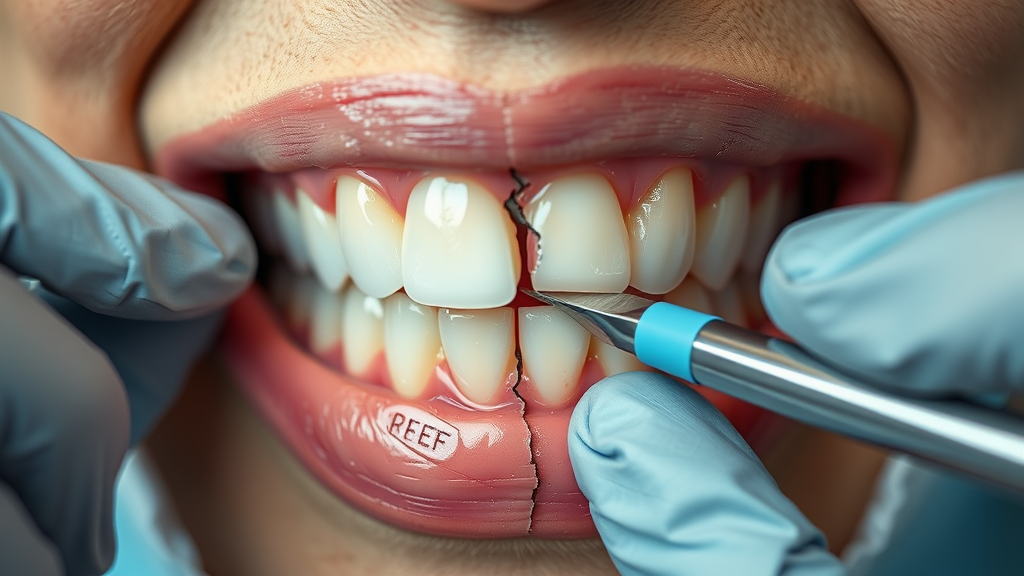Emergency Broken Filling Repair

Understanding Emergency Broken Filling Repairs and When You Need One
A broken filling can quickly turn from a minor inconvenience into a dental emergency that requires immediate attention. When a dental filling becomes damaged or falls out, it exposes the sensitive inner portions of your tooth, potentially leading to severe pain and complications if left untreated.
Signs Your Filling Needs Emergency Repair
Recognizing the signs of a broken filling is crucial for seeking timely treatment. You might experience sharp pain when biting down, increased sensitivity to hot or cold temperatures, or feel a rough edge with your tongue. Sometimes, you may even notice pieces of the filling material in your mouth or discover a visible hole where the filling used to be.
Common Causes of Broken Fillings
• Biting down on hard foods • Teeth grinding or clenching • Natural wear and tear over time • Decay developing around the filling • Impact or trauma to the tooth • Poor dental hygiene maintenance
Immediate Steps for Broken Filling Management
When you discover a broken filling, taking quick action can help prevent further damage. First, rinse your mouth with warm salt water to keep the area clean. Avoid chewing on the affected side and try temporary dental cement from a pharmacy if you can’t see a dentist immediately. However, these measures are only temporary solutions until you can receive professional care.
Why Quick Response Matters
A broken filling leaves your tooth vulnerable to bacteria and decay. Without the protective barrier of the filling, food particles and bacteria can enter the exposed area, potentially leading to infection or abscess. The longer you wait to address the issue, the higher the risk of needing more extensive and expensive treatments like root canals or extractions.
Professional Treatment Options
When you visit a dentist for emergency broken filling repair, they’ll evaluate the extent of the damage and recommend appropriate treatment. Often, they can replace the filling during the same visit. However, if significant decay is present or the tooth structure is compromised, you might need a crown or other restorative procedure.
What to Expect During Emergency Repair
• Thorough examination of the affected tooth • X-rays to check for underlying damage • Removal of any remaining old filling material • Cleaning and preparation of the tooth • Placement of new filling material • Adjustment for proper bite alignment
Preventing Future Filling Failures
While emergency repairs address immediate concerns, preventing future issues is equally important. Maintain regular dental check-ups to monitor the condition of your fillings. Practice good oral hygiene, including proper brushing and flossing techniques. If you grind your teeth, consider using a night guard to protect your dental work.
Being mindful of certain habits can also extend the life of your fillings:
• Avoid chewing ice or hard candies • Don’t use your teeth as tools to open packages • Address teeth grinding or clenching habits • Follow your dentist’s aftercare instructions • Schedule regular dental cleanings • Report any changes in your bite promptly
When faced with a broken filling, remember that prompt professional attention is crucial. While temporary measures can provide short-term relief, only a qualified dentist can properly assess and repair the damage. Keep your dentist’s emergency contact information readily available, and don’t hesitate to seek immediate care when you notice signs of filling damage. Your quick action can mean the difference between a simple repair and more complex dental procedures.
Common Causes Behind Damaged Dental Fillings
Understanding Dental Filling Damage
Dental fillings are essential treatments for restoring teeth affected by decay, but they don’t last forever. When a filling becomes damaged, it requires immediate attention to prevent further complications. Recognizing the various factors that can compromise your dental fillings helps you take better care of your oral health and know when to seek emergency treatment.
Physical Impact and Trauma
One of the most frequent causes of damaged fillings is direct physical trauma to the tooth. This can happen from biting down on hard objects, suffering a blow to the face, or encountering accidents during sports activities. Even seemingly harmless habits like chewing on ice, pens, or hard candies can gradually weaken your fillings. The impact force can cause the filling material to crack, chip, or completely dislodge from the tooth cavity.
Natural Wear and Aging
Over time, dental fillings naturally experience wear and tear from daily use. The constant pressure from chewing and grinding can cause the filling material to deteriorate. Most dental fillings have a lifespan of 5-15 years, depending on the material used and your oral care habits. Silver amalgam fillings typically last longer than composite resin ones, but both types eventually need replacement due to normal aging processes.
Poor Oral Hygiene Impact
Inadequate oral hygiene can significantly affect the longevity of your dental fillings. When you don’t maintain proper dental care, bacteria can accumulate around the filling edges, leading to secondary decay. This decay can compromise the bond between the filling and your natural tooth structure, causing the filling to become loose or fall out. Regular brushing, flossing, and professional cleanings are crucial for maintaining your fillings.
Teeth Grinding and Clenching
Bruxism, or teeth grinding, poses a serious threat to dental fillings. The excessive force applied during grinding or clenching can cause fillings to crack or break. Many people unknowingly grind their teeth during sleep, making it particularly challenging to prevent this damage. Using a night guard can help protect both your natural teeth and fillings from the harmful effects of bruxism.
Temperature-Related Stress
Extreme temperature changes in your mouth can affect filling integrity. When you consume very hot or cold foods and beverages in quick succession, the filling material expands and contracts. Over time, this thermal stress can create small gaps between the filling and tooth structure or cause the filling material to crack. Different filling materials react differently to temperature changes, with metal fillings being more susceptible to expansion and contraction.
Chemical Erosion Factors
Certain dietary habits can chemically erode both your teeth and fillings. Regular consumption of acidic foods and beverages, such as citrus fruits, sodas, and sports drinks, can gradually wear down filling materials. Additionally, some whitening products and harsh oral care products may affect the surface integrity of certain types of fillings, particularly composite ones.
Signs of Filling Damage
Identifying filling damage early helps prevent more serious complications. Watch for these warning signs:
• Sudden sensitivity to hot and cold • Sharp pain when biting down • Rough spots that your tongue can feel • Visible cracks or chips in the filling • Food frequently getting stuck around the filled tooth • A missing piece of the filling material
When you notice any of these signs, seeking immediate dental attention helps prevent the situation from worsening. Emergency dental care becomes particularly important if you experience severe pain or if the damaged filling exposes sensitive tooth structures. Remember that putting off necessary repairs can lead to more extensive and expensive dental procedures in the future.
Temporary Solutions Until Professional Help Arrives
When you discover a broken filling, quick action can help prevent further damage and discomfort until you can see a dentist. If you’re experiencing this dental emergency, several at-home solutions can provide temporary relief and protection for your tooth.
Safe Temporary Filling Materials
Over-the-counter dental cement kits offer a reliable temporary solution for broken fillings. These kits typically contain zinc oxide-based materials that can protect your tooth cavity. Before applying any temporary filling material, gently clean the affected area with warm salt water. Dry the area thoroughly with a clean cotton swab or piece of gauze.
Step-by-Step Application Process
• Clean your hands thoroughly before handling any dental materials • Rinse your mouth with warm salt water • Dry the affected tooth completely • Follow the specific mixing instructions for your temporary filling material • Apply the material carefully into the cavity • Avoid biting down for at least one hour
Keep in mind that temporary filling materials usually last between 24 to 48 hours. While these materials can protect your tooth, they’re not meant to be a permanent solution. Schedule a dental appointment as soon as possible.
Natural Alternatives for Emergency Relief
If you can’t access temporary filling materials immediately, several natural alternatives can help protect your tooth temporarily:
• Dental wax from your local pharmacy • Sugar-free gum (preferably orthodontic wax-based) • Temporary filling materials made from natural ingredients
These alternatives can provide short-term protection but should be replaced with proper temporary filling material as soon as possible.
Managing Pain and Discomfort
A broken filling can cause sensitivity and discomfort. While waiting for professional treatment, try these pain management techniques:
• Take over-the-counter pain relievers as directed • Apply clove oil to the affected area using a cotton swab • Avoid extreme temperatures in foods and beverages • Chew on the opposite side of your mouth • Maintain gentle oral hygiene around the affected area
Essential Prevention Tips
While waiting for your dental appointment, prevent further damage by:
• Avoiding hard, sticky, or chewy foods • Keeping the area clean with gentle brushing • Rinsing with warm salt water several times daily • Checking the temporary filling regularly for wear • Being mindful of grinding or clenching your teeth
Remember that any temporary solution is just that – temporary. These measures help protect your tooth and manage discomfort until professional treatment is available. Contact your dentist immediately to schedule an emergency appointment, as leaving a broken filling untreated can lead to more serious dental issues.
Most importantly, maintain regular dental check-ups to prevent filling failures in the future. Your dentist can identify potential problems with existing fillings before they break or cause emergency situations. Keep your dentist’s emergency contact information readily available, and don’t hesitate to call if you experience any dental emergencies, including broken fillings.
By following these temporary solutions and maintaining good oral hygiene, you can effectively manage a broken filling until professional help arrives. However, seek professional dental care as soon as possible to prevent complications and ensure proper restoration of your tooth.
Professional Treatment Options for Broken Fillings
When a filling breaks or falls out, seeking immediate professional dental care is crucial to prevent further complications. Dental professionals offer several effective treatment options tailored to address broken fillings and restore your oral health.
Immediate Dental Care Solutions
At the dental office, your dentist will first examine the affected tooth and assess the extent of damage. Using specialized tools and dental imaging, they’ll determine whether a simple replacement filling will suffice or if more extensive treatment is needed. Most dental practices prioritize emergency cases, often providing same-day appointments for broken fillings.
Direct Filling Replacement
The most straightforward solution involves removing any remaining old filling material and decay before placing a new filling. Modern dentists typically use tooth-colored composite materials that offer both durability and aesthetic appeal. This procedure usually takes about 30-45 minutes and can be completed in a single visit.
• Composite resin fillings • Glass ionomer fillings • Silver amalgam fillings • Gold inlay fillings
Advanced Restoration Methods
Dental Crown Installation
In cases where the broken filling has led to significant tooth structure loss, your dentist might recommend a dental crown. This protective cap covers the entire tooth surface, providing enhanced protection and stability.
• Porcelain crowns for optimal aesthetics • Metal crowns for maximum durability • Porcelain-fused-to-metal for combined benefits • Zirconia crowns for superior strength
Inlay and Onlay Procedures
Sometimes, the damage falls between needing a simple filling and a full crown. In such cases, inlays and onlays offer an excellent intermediate solution:
• Inlays fit within the cusps of your tooth • Onlays cover one or more cusps • Custom-made in a dental laboratory • Typically requires two appointments
Root Canal Considerations
If the broken filling has exposed the tooth’s pulp or led to infection, a root canal procedure might be necessary before the final restoration. During this treatment, your dentist will:
• Remove infected pulp tissue • Clean and shape the root canals • Fill the canals with special material • Place a temporary filling • Schedule a permanent restoration
Preventive Care Recommendations
Professional dentists emphasize the importance of preventive measures to extend the life of new restorations:
• Regular dental check-ups every six months • Professional cleaning and polishing • Proper brushing and flossing techniques • Avoiding hard foods and excessive grinding • Using nightguards if recommended
Emergency Temporary Solutions
While waiting for your dental appointment, dentists might suggest temporary measures:
• Using temporary filling materials from pharmacies • Avoiding chewing on the affected side • Keeping the area clean with warm salt water rinses • Taking over-the-counter pain relievers if needed
Insurance and Payment Options
Most dental practices offer various payment solutions for emergency filling repairs:
• Direct insurance billing • Payment plans and financing options • Credit card payments • Healthcare credit services • Emergency dental coverage plans
Remember that professional treatment for a broken filling should not be delayed, as postponing care can lead to more serious dental issues. Modern dental offices are equipped with advanced technology and materials to provide quick, effective solutions for broken fillings, ensuring your comfort and oral health are prioritized throughout the treatment process.
Preventive Measures to Protect Your Dental Fillings
Understanding Your Dental Fillings
Dental fillings are essential for maintaining oral health, but they require proper care to prevent emergency broken filling repairs. Taking proactive steps to protect your fillings can save you from unexpected dental emergencies and costly repairs. While fillings are designed to be durable, certain habits and behaviors can significantly impact their longevity.
Daily Habits That Protect Your Fillings
Maintaining good oral hygiene is your first line of defense against filling damage. Brush your teeth twice daily using a soft-bristled toothbrush and fluoride toothpaste. Pay special attention to the areas around your fillings, as these spots can accumulate bacteria and food particles. Flossing daily helps remove debris between teeth and around filling edges, preventing decay that could compromise the filling’s integrity.
Smart Dietary Choices
Your food choices play a crucial role in preserving dental fillings. Avoid extremely hard foods that can crack or damage fillings, such as:
• Ice cubes • Hard candies • Unpopped popcorn kernels • Nuts and seeds • Hard crusty bread
Additionally, limit sugary and acidic foods that can erode the tooth structure around fillings. When consuming these items, rinse your mouth with water afterward to neutralize harmful acids.
Professional Care and Maintenance
Regular dental check-ups are vital for monitoring the condition of your fillings. Your dentist can detect early signs of wear or damage before they develop into emergencies. Professional cleanings help remove tough plaque and tartar that can accumulate around filling edges, potentially leading to decay or loosening.
Protective Measures During Activities
If you participate in sports or grind your teeth at night, wearing appropriate protective gear is essential. A custom-fitted mouthguard can prevent impact damage to your fillings during physical activities. For nighttime teeth grinding (bruxism), your dentist may recommend a night guard to protect both your natural teeth and fillings from excessive pressure and wear.
Warning Signs to Monitor
Being aware of potential filling problems helps you address issues before they become emergencies. Watch for:
• Sensitivity to hot and cold temperatures • Pain when biting down • Rough edges around the filling • Visible cracks or chips • Food frequently getting stuck around the filling • Changes in the filling’s texture or appearance
Lifestyle Adjustments
Certain habits can significantly impact filling longevity. Avoid using your teeth as tools to open packages or bottles. If you smoke or use tobacco products, consider quitting, as these habits can weaken the bond between your filling and tooth structure. Additionally, maintain proper hydration to ensure adequate saliva production, which helps protect both your teeth and fillings.
Remember that even with excellent care, fillings don’t last forever. Most dental fillings have a lifespan of 5-15 years, depending on the material used and how well they’re maintained. By implementing these preventive measures and staying vigilant about your oral health, you can maximize your filling’s lifespan and minimize the risk of requiring emergency broken filling repairs. When in doubt about the condition of your fillings, don’t hesitate to consult your dentist for professional assessment and guidance.
Conclusion
Taking care of your dental fillings is crucial for maintaining your oral health and preventing emergency situations. While broken fillings can be stressful, knowing how to identify the problem, understanding the causes, and having temporary solutions can help you manage until you receive professional care. Remember that emergency broken filling repair services are widely available, and dentists prioritize these cases to prevent further complications.
By following preventive measures like maintaining good oral hygiene, avoiding hard foods, and scheduling regular dental check-ups, you can significantly reduce the risk of damaged fillings. If you experience a broken filling, don’t panic – temporary dental cement kits and other home remedies can provide short-term relief, but they should never replace professional dental care.
Your dentist has various treatment options available, from simple repairs to complete filling replacements, depending on the extent of the damage. The key is to act quickly when you notice any issues with your filling to prevent more serious dental problems. Remember that modern dental techniques and materials make the repair process more comfortable and long-lasting than ever before.
Stay proactive about your dental health, and don’t hesitate to contact your dentist at the first sign of a broken filling. Quick action, combined with proper maintenance and regular dental visits, will help ensure your fillings last longer and continue protecting your teeth effectively. Your smile is worth the investment in proper dental care and timely repairs when needed.

